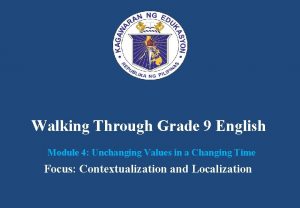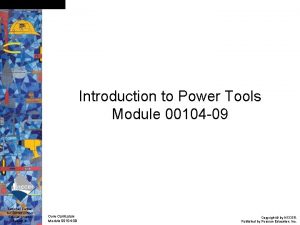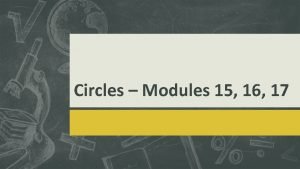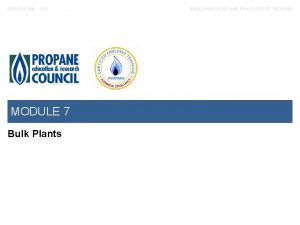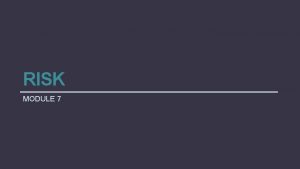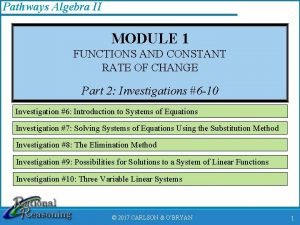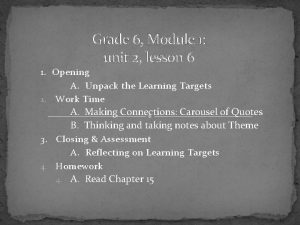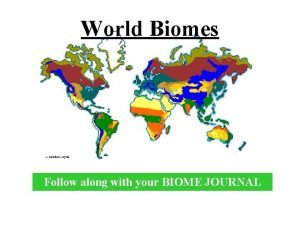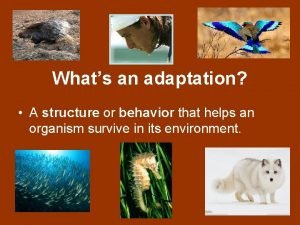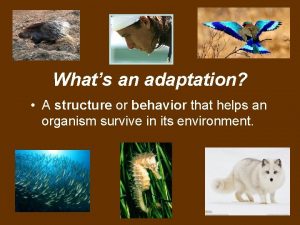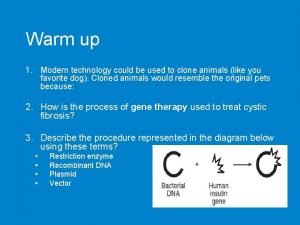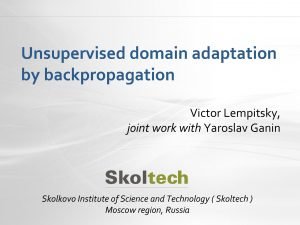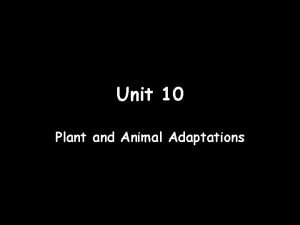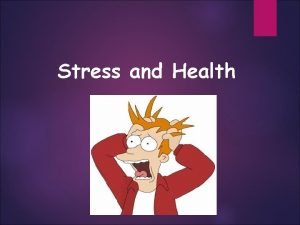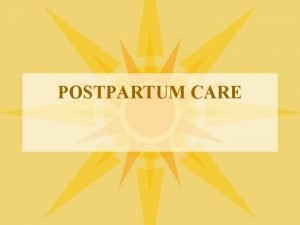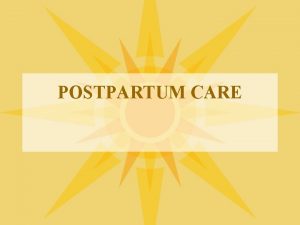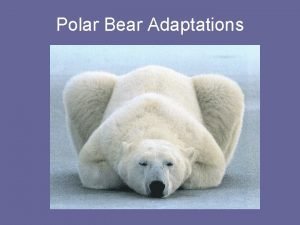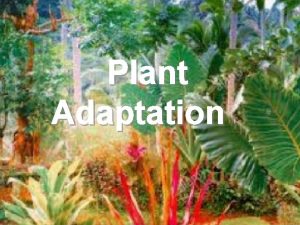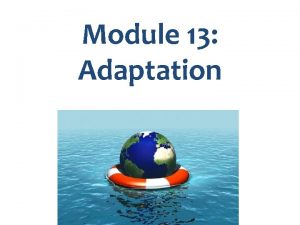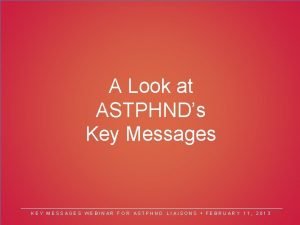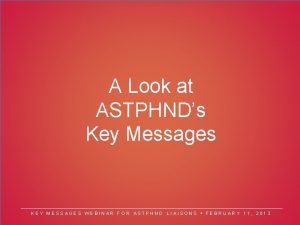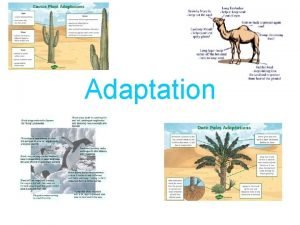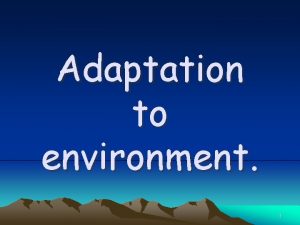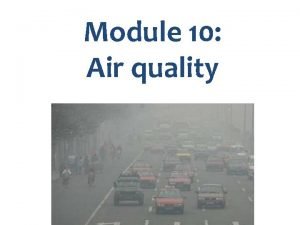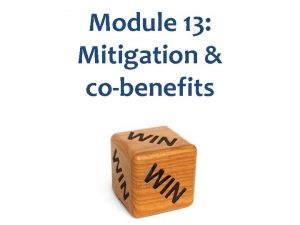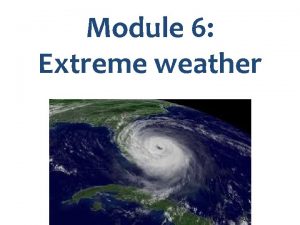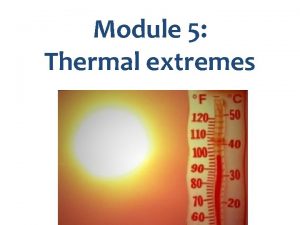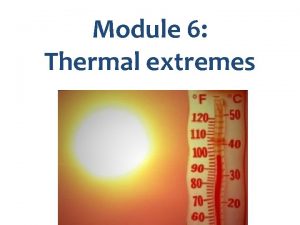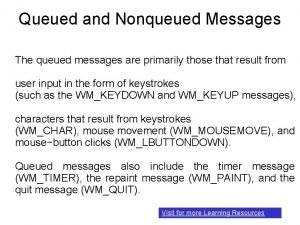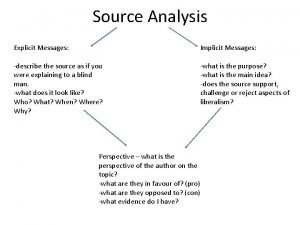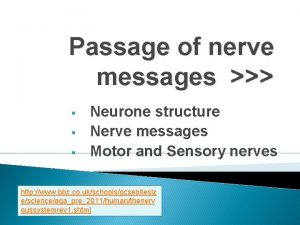Module 12 Adaptation Key messages in Module 12











































- Slides: 43

Module 12: Adaptation

Key messages in Module 12 • Strong health systems are essential for adaptation • Importance of developing climate-resilient health systems 2

Module 12 outline 1 2 3 Theory & Adaptation practice of assessment activity e. g. ’s in adaptation process WP & SEA 3

1 THEORY & PRACTICE OF ADAPTATION 4

Adaptation Definition: Actions taken by individuals, institutions, corporate sector & governments to address the risks of climate change directly or indirectly through addressing factors that increase vulnerability Goal of adaptation: to prepare for, & effectively respond to, the health risk of climate change • Adaptation can be: – Anticipatory – Responsive 5

Adaptation The process of adaptation can be: – Incremental - actions where the central aim is to maintain the essence & integrity of a system or process at a given scale OR – Transformational - changes the fundamental attributes of a system in response to climate & its effects 6

Source: Who (2014) 7

Integrating a HNAP within the NAP process & existing national health planning Source: WHO (2014) 8

E. g. : Baseline measures for monitoring the effects of climate change on malnutrition Source: WHO (2014) 9

10

Ways climate change affects health Source: IPCC (2013) 11

IMPACTS EMISSIONS & Land-use Change Source: IPCC (2013) 12

Context for adaptation • Climate change is one of many factors influencing human health & social well-being – In most cases, it multiplies the threats of current drivers of climate-sensitive health outcomes • Public health challenges presented by climate change need to be addressed within the context of issues such as access to clean water & sanitation, inadequate nutrition, & diseases such as HIV/AIDS • Poverty is a major factor 13

Local context matters • Multiple political, social, economic, technological, & human factors determine whether adaptation strategies, policies, & measures are effective • Therefore, differences in culture, education, knowledge, availability & affordability of technology, & other factors mean that a ‘one size fits all’ approach is likely to fail 14

THE PROCESS OF CONDUCTING AN ADAPTATION ASSESSMENT 15

Framework for Adaptation Source: UK Climate Impacts Programme (2006) 16

WHO guidance document on conducting an assessment Being used to conduct vulnerability & adaptation assessments in Asia & the Pacific Includes 3 categories of assessment activities: 1. Framing & scoping the assessment 2. Conducting the assessment 3. Managing & monitoring risks Available at: http: //who. int/globalchange/publications/Final_Climate_Change. pdf 17

First step in an assessment: What is the purpose? • Who will the audience be? • What questions would the audience like addressed? • Information needed to answer the questions? • How will the final results be most effectively presented? 18

Steps in an adaptation assessment 1. Determine the scope of the assessment • Region • Health outcome(s) 2. Identify & convene stakeholders 3. Identify & evaluate current strategies, policies & measures to reduce that burden (adaptation baseline) 19

Steps in an adaptation assessment 4. Estimate future potential health impacts using socioeconomic & climate change scenarios – Can be qualitative or quantitative 5. Identify additional adaptation measures to reduce potential negative health effects 20

Public health adaptation to climate change • Existing risks • Modifying existing prevention strategies • Reinstitute effective prevention programs that have been neglected or abandoned • Apply win-win or no-regrets strategies • New risks 21

Vulnerability & adaptation assessment process 22

Has your country conducted a vulnerability & adaptation assessment? What was the process & outcome? 23

Questions for identifying adaptation policies & measures Adaptation to what? What is the current burden of disease? Is additional intervention needed? What are the future projections for the climate-sensitive health outcome? • Who is vulnerable? • On scale relevant for adaptation? • • 24

Further questions for identifying adaptation policies & measures • • Who adapts? How does adaptation occur? When should interventions be implemented? How good or likely is the adaptation? 25

Adaptation baseline • What is being done now to reduce the burden of climate-sensitive health outcomes? How effective are these policies & measures? • What could be done now to reduce current vulnerability? What are the main barriers to implementation (such as technology or political will)? • What measures should begin to be implemented to increase the range of possible future interventions? 26

Particularly vulnerable populations (using a flood as an example) • Glacial lake floods: Elderly, poor, nomadic, children, disabled or infirm, women, independently living ethnic groups in remote areas • Flash: Everyone in the path of the floods • Riverine (plains): Elderly, poor, nomadic, children, the disabled or sick, women, & people in poor housing, coastal areas, institutions, or on isolated islands 27

Adaptation options to reduce the health impacts of climate change Health Outcome Thermal stress Legislative Extreme weather events Planning laws, economic incentives for building Building guidelines Technical Educational & advisory Housing, public Early warning buildings, urban systems planning, air conditioning Urban planning, Early warning storm shelters systems Cultural & Behavioral Clothing, siesta Use of storm shelters Source: Mc. Michael et al. (2003) 28

Adaptation options to reduce the health impacts of climate change Health Outcome Legislative Technical Educationaladvisory Cultural & Behavioral Vector-borne diseases Vector control, vaccination, impregnated bed nets, sustainable surveillance, prevention & control programmes Health education Water storage practices Water-borne Watershed diseases protection laws, water quality regulation Screening for Boil water pathogens, improved alerts water treatment & sanitation Washing hands and other behavior, use of pit latrines Source: Mc. Michael et al. (2003) 29

Steps in an adaptation assessment 1. Determine the scope of the assessment 2. Identify & convene stakeholders 3. Identify & evaluate current strategies, policies & measures to reduce that burden 4. Estimate future potential health impacts 5. Identify additional adaptation measures 30

Examples of adaptation activities in the WP & SEA region 31

Surveillance system in Bhutan: Collecting weather data 32

Surveillance system in Bhutan: Collecting health data 33

New Civil Hospital, Surat, Gujarat, India 34

Sea surface temperature monitoring in South Atlantic helps predict malaria outbreaks in India 35

Disaster warning systems in Mongolia Source: UNEP (2014) 36

Adaptation measures to reduce health outcomes from floods • Legislative policies – Improve land use planning • Decision support tools – Early warning systems & emergency response plans • Technology development • Surveillance & monitoring – Alter health data collection systems to monitor for disease outbreaks during & after an extreme event 37

Adaptation measures to reduce health outcomes from floods • Infrastructure development − Design infrastructure to withstand projected extreme events • Other − Conduct research on effective approaches to encourage appropriate behavior during an extreme event 38

Framework for Adaptation Source: UK Climate Impacts Programme (2006) 39

What we covered in Module 12 Theory & Adaptation practice of assessment activity e. g. ’s in adaptation process WP & SEA 40

Learning from Module 12 • Strong health systems are essential for adaptation • Importance of developing climate-resilient health systems 41

What action will you take in your work, given what you learnt in Module 12? 42

Coming up next… Module 11: Assessing health vulnerability 43
 Which key resources are we acquiring from partners
Which key resources are we acquiring from partners Contoh bisnis model canvas makanan pdf
Contoh bisnis model canvas makanan pdf Secure key loader
Secure key loader C device module module 1
C device module module 1 English module grade 9 with answers
English module grade 9 with answers Module 00104 introduction to power tools answer key
Module 00104 introduction to power tools answer key Principles of marketing quarter 2 -- module 7
Principles of marketing quarter 2 -- module 7 Principles of marketing quarter 2 module 6
Principles of marketing quarter 2 module 6 Principles of marketing module 2 answer key
Principles of marketing module 2 answer key The basic rule of a risk-to-return relationship is that …
The basic rule of a risk-to-return relationship is that … Icici learning matrix answer key
Icici learning matrix answer key Module 16 arc length and sector area answer key
Module 16 arc length and sector area answer key Business math ratio and proportion
Business math ratio and proportion Propane module 7 answer key
Propane module 7 answer key Module 7 managing risk answer key
Module 7 managing risk answer key Pathways algebra 2 answer key
Pathways algebra 2 answer key Nishtha module 8 answer key in english
Nishtha module 8 answer key in english Grade 6, module 1, unit 2 answer key
Grade 6, module 1, unit 2 answer key Safe plates module 1 answer key
Safe plates module 1 answer key Science 14 module 1 answer key
Science 14 module 1 answer key Nature of science technology and society
Nature of science technology and society Module 15 angles and segments in circles
Module 15 angles and segments in circles Grade 6 module 1: unit 2 answer key
Grade 6 module 1: unit 2 answer key Key partner module
Key partner module Bougainvillea adaptations
Bougainvillea adaptations Definition of structural adaptation
Definition of structural adaptation Behavioral adaptation
Behavioral adaptation Why is artificial selection used
Why is artificial selection used Unsupervised domain adaptation by backpropagation.
Unsupervised domain adaptation by backpropagation. Grassland animal adaptations
Grassland animal adaptations Plants of temperate deciduous forest
Plants of temperate deciduous forest General adaptation syndrome uitleg
General adaptation syndrome uitleg Color constancy psychology definition
Color constancy psychology definition Sensory adaptation
Sensory adaptation Cycas revoluta
Cycas revoluta Adaptation definition science
Adaptation definition science Adaptation psychology piaget
Adaptation psychology piaget L
L Lochia alba smell
Lochia alba smell Polar bear adaptations for protection
Polar bear adaptations for protection What is the function of stems?
What is the function of stems? Structural adaptation examples
Structural adaptation examples Poison oak adaptations
Poison oak adaptations Stone plants
Stone plants




